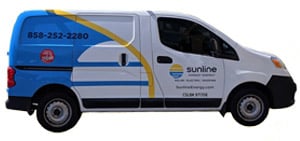Over the next 2 articles, we explore how to get the most out of that investment – using a blend of energy efficiency strategies. By implementing the steps in this 2-part series, you can derive optimal returns from your San Diego solar installation.
How Does Energy Efficiency Increase Solar Returns?
Thanks to San Diego’s net metering program, you’re allowed to sell excess solar electricity to the utility at a profit. At the end of each billing cycle, if you’ve sold more electricity than you’ve consumed, it’s possible to have a negative electricity bill (you heard correctly – “negative” bills).
With this understanding, some San Diego homeowners buy larger solar installations than they need. Doing so ensures that they’ll always have excess electricity to sell.
The other (much cheaper) option is to simply reduce the amount of electricity you consume.
This is where energy efficiency comes in.
Without further ado.
1. Using Energy Efficient Appliances
By using EPA-approved Energy Star appliances, you can reduce the amount of electricity that your electronics use by as much as 50%.
Although many of these Energy Star appliances cost more upfront, they quickly pay for themselves through long-term electricity bill savings.
2. Lower Your Hot Water Heater
For most household cleaning, hot water only needs to be 140 degrees or less (60 degrees Celsius). This is as true for laundry and dishes as it is for showers and cooking.
If the temperature of the water rises above 140 degrees, your plumbing system will add cooler water to bring temperatures down to acceptable levels. And thus, by setting the maximum temperature to 140 degrees, you can save a lot of money and energy every month.
3. Stop Leaks Before They Happen.
For most standard homes, cooling and heating account for more than 50% of total energy consumption. This figure is on the higher end if your home has leaks, cracks, and other ways for outside temperatures to seep in.
By plugging leaks with sealant, you can dramatically reduce your monthly HVAC energy needs.
4. Washing, Drying, and Food Storage
You probably already understand the wisdom behind only doing full loads of laundry. Washing and drying machines are notorious energy hogs, so it makes sense to put off cleaning for as long as possible.
But did you know that refrigerators and freezers also operate best when they’re full. High-density food storage units maintain cold temperatures more efficiently than low-density ones do.
Keep your fridge full and your energy costs down.
5. Switch to Off-peak Energy Use
Solar panels operate at peak performance when the sun is shining (no surprise there). This is also precisely when grid electricity is most expensive.
By shifting your daytime activities to the evening, you can avoid buying expensive grid electricity and maximize the amount of clean solar electricity you sell to the grid.
For most San Diego solar customers, this shift isn’t a big issue. They usually work at offices and aren’t around during the day.
But if you’re a stay-at-home parent or if you work at home, consider saving your most “energy-intensive” activities for off-peak hours. Doing so will help you optimize the returns on your San Diego solar installation.
More Energy Efficiency Tips for Boosting the ROI of Your Solar Investment
Stay tuned for Part 2 of this series on energy saving tips to boost your solar returns.
In the meantime, if you have questions about installing solar panels on your residential or commercial property, contact us today for a free consultation.

